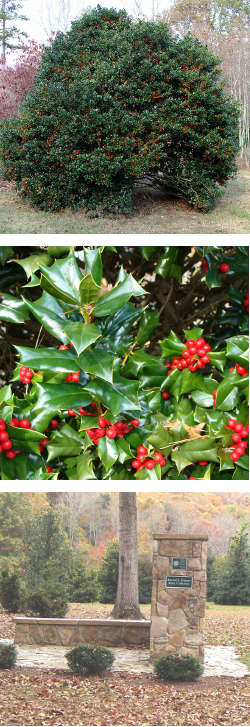
Inspired by the late Harold Elmore, The Holly Collection at the University of Tennessee Arboretum is a research and display garden of over two hundred cultivars of the genus Ilex. Mr. Elmore, a past president of the University of Tennessee Arboretum Society as well as the Holly Society of America, was world renowned for his holly expertise and was frequently referred to as “Mr. Holly”. The landscape design for the collection was a collaborative project of Mr. Elmore, Richard Evans, former UT Arboretum director, and the late Lois Good, landscape designer and past president of the University of Tennessee Arboretum Society. The collection follows her concept of grouping according to species and hybrid associations. The current inventory was compiled by members of the UT Arboretum Society Holly Task Force, Fran Scheidt and Dr. Willard Witte, UT Associate Professor Emeritus. The Task Force also donated black and gold permanent metal signs for all specimens in the collection.
The Elmore Holly Collection is recognized by the Holly Society of America as an Official Holly UT Arboretum. The Collection is located along UT Arboretum Road near the Heath Cove Trail, one of the self-guided Walking Trails at the UT Arboretum.
Hollies (Ilex species)

Hollies have been associated with the winter solstice since ancient times. They are found throughout the world occupying a wide range of habitats. More than 780 evergreen hollies and 30 deciduous hollies have been recognized. Although North America is not considered a major center of holly diversity, it does have 23 native hollies, with 7 occurring in Tennessee. Many holly cultivars have been developed and are used extensively in landscaping. Hollies have a rich history of medicinal uses and have been regarded as religious symbols. They are also used widely for wreaths and other holiday decorations.
American Holly (Ilex opaca) is found as an understory tree in a variety of habitats throughout the UT Arboretum. Although it can grow to heights of 50 to 60 feet, most of the trees along the trails are much smaller, reflecting their slow growth rate and the relatively recent disturbance history of our forests. After leaf fall in the autumn, American Hollies with their spiny, evergreen leaves become more readily visible. The fruits (4-seeded drupes) are collected along with the leaves for Christmas wreaths and other holiday decorations. The fruits are eaten by birds and small mammals, but can be toxic to humans and pets. The wood is suitable for inlays in cabinet work, handles, carvings, rulers, and scientific instruments. When dyed black to resemble ebony, the wood is used for violin pegs, piano keys, and fingerboards.
The Harold L. Elmore Holly Collection at the UT Arboretum is a research and display garden containing over 200 evergreen and deciduous Holly cultivars. The collection is named in honor of the late Harold Elmore, a past president of the University of Tennessee Arboretum Society and the Holly Society of America. It is recognized by the Holly Society of America as an official collection of Hollies, and was written up in the Tennessee Farm Bureau’s Home and Garden Magazine (Fall 2014). Other Holly plantings are found in the Marsh Area and along Valley Drive and Shade Tree Lane.
Choose among the links below to view a map of the holly site or browse a list of cultivars in the collection.